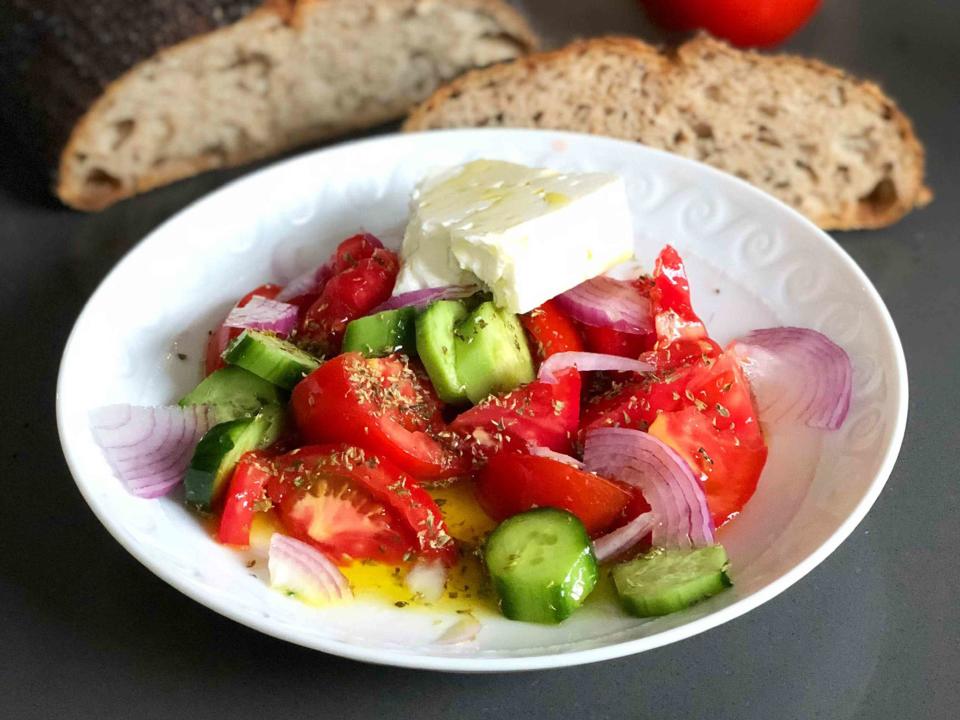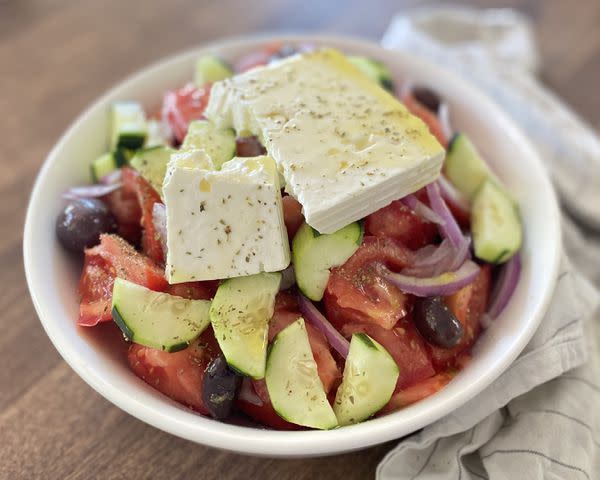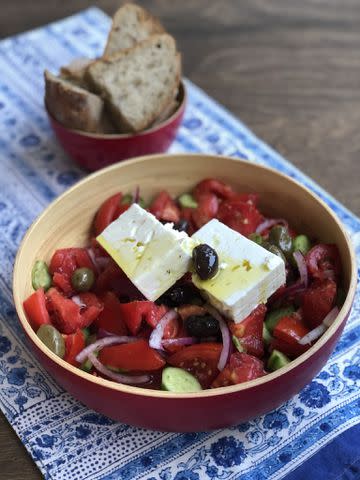Greek People Don’t Use Vinegar in Their Greek Salads—They Do This Instead
I just learned how to make a real Greek salad, and it's even easier than I expected.

A Greek salad is the ultimate summer dish. It’s cool, crisp, and refreshing, and cuts through any rich BBQ dish you just took off the grill.
Best of all, the recipe is unbelievably simple. I suspect you could whip it up without a recipe at all. But, what if I told you that you’ve probably been making Greek salad wrong all along?
Most of the classic components are the same—tomatoes, cucumbers, red onions, and olives. But one significant difference sets an authentic Greek salad apart from the popularized version you eat at your local lunch spot—there is no vinegar or lemon juice in the dressing.
My mind was blown when Allrecipes Editorial Director and Greek cuisine expert Diana Moutsopoulos shared this food knowledge with me. “Lemon juice? That sounds disgusting,” she said.
Wait, what? Isn’t that pop of acidity crucial to making the medley of flavors sing?
Well, not exactly. In traditional Greek cooking, there is a way to give the fresh vegetable dish a rounder, softer pop of flavor that isn’t as astringent as a shot of red wine vinegar, and in it lies the real beauty of the famed Mediterranean dish.
Hint: It doesn’t require any extra ingredients at all.

Where Did the Greek Salad Come From?
You might assume (as I did) that the Greek salad has been a staple in Greek cuisine since ancient times, but boy, is that wrong. In fact, tomatoes—the main ingredient—didn’t even exist in Greece until the early 19th century. Turns out, the Greek salad we know today was actually born in the 1960s in Plaka during the country’s first tourism boom.
The traditional name is "Horiatiki," meaning village salad, and it’s primarily a summer dish, made with veggies and olive oil. Rumor has it, feta cheese was added to the salad to sidestep government-set prices and make the dish more profitable for restaurants. Now we couldn't imagine the salad without it.
An authentic Greek salad is dressed in nothing but oil—but don’t worry, that doesn’t mean the salad is light on flavor. The flavor of the "dressing" is actually extracted from the fresh tomatoes by using salt and time.
How to Make a Greek Salad the Authentic Way
Start with ripe, juicy tomatoes. "The best way to do it is to cut chunks, not perfect wedges, but irregular, big chunks," Moutsopoulos instructs. Cutting the tomatoes over the serving bowl will ensure you don’t lose any juice. Next, stir in a generous pinch of sea salt.
Then, the key step: Let the tomatoes sit in the salt for anywhere between 10 and 30 minutes. This will draw out the juices and create a beautiful, flavorful tomato broth at the bottom of the bowl. To that, add the rest of your ingredients (cucumber, red onion, olives, olive oil, etc.), stir, and serve. Simple, elegant, and delicious.
This is a time when you want to use a good, peppery extra virgin olive oil with a nice color and body. Besides salt (and maybe some dried oregano), it’s the only flavoring added, so you want it to have as much flavor as possible.
As for the feta cheese, don’t go crumbling it on top or stirring it in. Believe me, I like an abundance of feta just as much as the next person, but the traditional way of serving the salad is with the feta intact. “It’s a slice or a slab on top, or perhaps two, but never crumbled and stirred,” Moutsopoulos shared.
Of course, there are plenty of regional variations. Some common additions are pickled caper leaves, caper berries, purslane, and green peppers, but the staple ingredients are the same.
Another sign of a real-deal Greek salad? There’s no lettuce. The fresh, rustic-style salad is traditionally a summer dish. In Greece, lettuce primarily grows in the winter months, so it’s not included.

So, Why Do We Add Vinegar to Greek Salads?
Extracting the tomato juice adds the acidity that gives all the rest of the ingredients incredible depth, freshness, and flavor, but it does take a decent amount of time. A shortcut? You can add flavor fast by tossing in a bit of vinegar.
“Probably, to be honest, a big reason why it might happen sometimes in Greece is because the restaurant doesn’t have time,” Moutsopoulos notes. In the fast-food-fueled culture we live in, it's no wonder the American-style Greek salad has adopted a vinegar base.
The Most Important Part of Eating a Greek Salad
The final requirement? “You absolutely have to have good crusty bread with your Greek salad,” says Moutsopoulos.
“All that juice and oil is what people fight over,” she says. That broth at the bottom of the bowl is so desired, there’s even a word for it in Greek: papara. “It’s the best part of the salad—you cannot let it go to waste.”
Knowing how to make a traditional Greek salad is exactly what we need for the warmer days ahead. The next time you make this go-to summer dish, try it the authentic way and taste the difference for yourself.
Read the original article on All Recipes.


